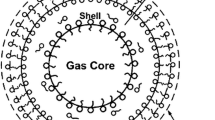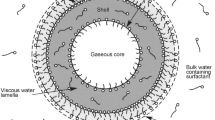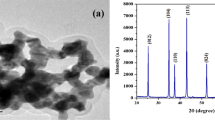Abstract
Colloidal gas aphrons (CGAs) are progressive operational fluids used in different areas such as engineering fields due to their unique characteristics. In between, the application of nanoparticle in several fields of engineering has received considerable attention in recent years. However, little or no information is available regarding the application of nanoparticle in CGA suspensions. In this study, the size distribution of bubbles, stability, API filtrate and rheology of a new type of these fluids called nanoparticle-enhanced colloidal gas aphron (NCGA)-based fluids are investigated. NCGAs’ stability is studied by measuring drainage rate tests. Also, for the investigation of fluid flow behavior, six rheological models are exerted, and their applicability is studied. The results of this study show that CGA system along with nanoparticles can be a successful combination for efficient system stability, improved filter loss, and better rheological behavior. It showed that NCGA fluid with the composition of (% w/v): xanthan gum (XG): 0.571, starch: 4.286, surfactant: 0.857, NaCl: 0, and nanoparticles: 0.428, has the best efficiency in improving the NCGA fluid properties.





















Similar content being viewed by others
Abbreviations
- AARE:
-
Average absolute relative error
- RMSE:
-
Root-mean-square error
References
N. Bjorndalen, W.E. Jossy, J.M. Alvarez, E. Kuru, A laboratory investigation of the factors controlling the filtration loss when drilling with colloidal gas aphron (CGA) fluids, in SPE International Symposium and Exhibiton on Formation Damage Control. Society of Petroleum Engineers, Lafayette, Louisiana, USA (2010)
T. Brookey, “Micro-bubbles”: new aphron drill-in fluid technique reduces formation damage in horizontal wells, in SPE Formation Damage Control Conference, Lafayette, Louisiana (1998)
F.B. Growcock, A.M. Khan, G.A. Simon, Application of water-based and oil-based aphrons in drilling fluids, in International Symposium on Oilfield Chemistry, Houston, Texas (2003)
C. Ivan, F. Growcock, J. Friedheim, Chemical and physical characterization of Aphron-based drilling fluids, in SPE Annual Technical Conference and Exhibition, San Antonio, Texas (2002)
C.D. Ivan, J.L. Quintana, L.D. Blake, Aphron-base drilling fluid: evolving technologies for lost circulation control, in SPE Annual Technical Conference and Exhibition, New Orleans, Louisiana (2001)
W.F. MacPhail, R.C. Cooper, T. Brookey, R. Robinson, J. Paradis, Adopting aphron fluid technology for completion and workover applications, in SPE International Symposium and Exhibition on Formation Damage Control, Lafayette, Louisiana, USA (2008)
F. Ramirez, R. Greaves, J. Montilva, Experience using microbubbles-aphron drilling fluid in mature reservoirs of Lake Maracaibo, in International Symposium and Exhibition on Formation Damage Control, Lafayette, Louisiana (2002)
C. White, P. Adrian, C. Ivan, S. Maikranz, R. Nouris, Aphron-based drilling fluid: novel technology for drilling depleted formations in the North Sea, in SPE/IADC Drilling Conference, Amsterdam, Netherlands (2003)
F. Sebba, Foams and Biliquid Foams-Aphrons (Wiley, New York, 1987)
L.S. Spinelli et al., Synthetic-based aphrons: correlation between properties and filtrate reduction performance. Colloids Surf. A 353(1), 57–63 (2010)
M. Arabloo, M. Pordel Shahri, Experimental studies on stability and viscoplastic modeling of colloidal gas aphron (CGA) based drilling fluids. J. Petrol. Sci. Eng. 113, 8–22 (2014)
M. Arabloo, M.P. Shahri, M. Zamani, Characterization of colloidal gas aphron-fluids produced from a new plant-based surfactant. J. Dispers. Sci. Technol. 34(5), 669–678 (2012)
M. Arabloo Narehei, M. Pordel Shahri, M. Zamani, Rheological and filtration loss characteristics of colloidal gas aphron based drilling fluids. J. Jpn. Petrol. Inst. 55(3), 182–190 (2012)
N. Bjorndalen, J. Alvarez, E. Jossy, E. Kuru, A study of the effects of colloidal gas aphron composition on pore blocking. SPE Drill. Complet. 26(01), 139–150 (2011)
N. Bjorndalen, E. Kuru, Physico-Chemical Characterization of Aphron Based Drilling Fluids, in Canadian International Petroleum Conference, Calgary, Alberta (2005)
F. Growcock, Enhanced wellbore Stabilization and Reservoir Productivity with Aphron Drilling Fluid Technology, Final Report, DPE Award Number DEFC26- 03NT42000 (2005)
S. Shivhare, E. Kuru A study of the pore-blocking ability and formation damage characteristics of oil-based colloidal gas aphron drilling fluids. J Pet Sci Eng 2014 122:257–65
S. Shivhare, E. Kuru, Rheology and stability of non-aqueous micro bubble based drilling fluids, in SPE International Symposium on Oilfield Chemistry, The Woodlands, Texas, USA (2011)
A. Tabzar, M. Arabloo, M.H. Ghazanfari, Rheology, stability and filtration characteristics of colloidal gas aphron fluids: role of surfactant and polymer type. J. Nat. Gas Sci. Eng. 30(26), 895–906 (2015)
H. Ziaee, M. Arabloo, M.H. Ghazanfari, D. Rashtchian, Herschel–Bulkley rheological parameters of lightweight colloidal gas aphron (CGA) based fluids. Chem. Eng. Res. Des. 93, 21–29 (2015)
M. Arabloo, M. Pordel Shahri, M. Zamani, Preparation and characterization of colloidal gas aphron based drilling fluids using a plant-based surfactant, in SPE Saudi Arabia Section Technical Symposium and Exhibition, Al-Khobar, Saudi Arabia (2012)
J.T. Srivatsa, M.B. Ziaja, An experimental investigation on use of nanoparticles as fluid loss additives in a surfactant - polymer based drilling fluids, in International Petroleum Technology Conference, Bangkok, Thailand (2011)
M. Amanullah, A.M. Al-Tahini, Nano-technology-its significance in smart fluid development for oil and gas field application, in SPE Saudia Arabia Section Technical Symposium, AlKhobar, Saudi Arabia (2009)
K.P. Hoelscher, G. De Stefano, M. Riley, S. Young, Application of nanotechnology in drilling fluids, in SPE International Oilfield Nanotechnology Conference and Exhibition, Noordwijk, The Netherlands (2012)
L. Li, X. Xu, J. Sun, X. Yuan, Y. Li, Vital role of nanomaterials in drilling fluid and reservoir protection applications, in Abu Dhabi International Petroleum Conference and Exhibition, Abu Dhabi, UAE (2012)
Z. Xu, Application of nanotechnology on borehole wall stability in gas–liquid medium transition during gas drilling, in SPE Annual Technical Conference and Exhibition, San Antonio, Texas, USA (2012)
M. Zakaria, M.Husein, G. Harland, Novel nanoparticle-based drilling fluid with improved characteristics. InSPE international oilfield nanotechnology conference (2012)
T. Sensoy, M.E. Chenevert, M.M. Sharma, Minimizing water invasion in shales using nanoparticles, in SPE Annual Technical Conference and Exhibition, New Orleans, Louisiana (2009)
S. Agarwal, T.X. Phuoc, Y. Soong, D. Martello, R.K. Gupta, Nanoparticle-stabilised invert emulsion drilling fluids for deep-hole drilling of oil and gas. Can. J. Chem. Eng. 91(10), 1641–1649 (2013)
Z.Vryzas, Z. Kelessidis, V.C. Bowman, M.B. Nalbantian, L. Zaspalis, V. O. Mahmoud, and H.A . Nasr-El-Din Smart magnetic drilling fluid with in-situ rheological controllability using Fe 3 O 4 nanoparticles. In : SPE middle east oil & gas show and conference. Society of petroleum engineers (2017)
J. Cai, S. Gu, F. Wang, X. Yang, Y. Yue, X. Wu, V.F. Chixotkin, Decreasing coalbed methane formation damage using micro foamed drilling fluid stabilized by silica nanoparticles. J. Nanomater. 2016, 52 (2016)
H. Pham, Q.P. Nguyen, Effect of silica nanoparticles on clay swelling and aqueous stability of nanoparticle dispersions. J. Nanopart. Res. 16(1), 1–11 (2014)
J. Abdo, M.D. Haneef, Nano-Enhanced drilling fluids: Pioneering approach to overcome uncompromising drilling problems. J. Energy Res. Technol. 134(1), 014501 (2012)
M. Amanullah, M.K. AlArfaj, Z.A. Al-abdullatif, Preliminary test results of nano-based drilling fluids for oil and gas field application, in SPE/IADC drilling conference and exhibition, Amsterdam, The Netherlands (2011)
K. Anoop, R. Sadr, M. Al-Jubouri, M. Amani, Rheology of mineral oil-SiO2 nanofluids at high pressure and high temperatures. Int. J. Therm. Sci. 77, 108–115 (2014)
L. Quintero, A.E. Cardenas, D.E. Clark, Nanofluids and methods of use for drilling and completion fluids, US Patent (2011)
A. Samsuri, A. Hamzah, Water based mud lifting capacity improvement by multiwall carbon nanotubes additive. J. Petrol. Gas Eng. 2(5), 99–107 (2011)
R. Caenn, G.V. Chillingar, Drilling fluids: State of the art. J. Petrol. Sci. Eng. 14(3–4), 221–230 (1996)
R.C. Navarrete, et al., Experiments in fluid loss and formation damage with xanthan-based fluids while drilling, in IADC/SPE Asia Pacific Drilling Technology, Kuala Lumpur, Malaysia (2000)
M. Khalil, B. Mohamed Jan, Herschel–Bulkley rheological parameters of a novel environmentally friendly lightweight biopolymer drilling fluid from xanthan gum and starch. J. Appl. Polym. Sci. 124(1), 595–606 (2012)
A.D. Monfared, M.H. Ghazanfari, M. Jamialahmadi, A. Helalizadeh, Adsorption of silica nanoparticles onto calcite: equilibrium, kinetic, thermodynamic and DLVO analysis. Chem. Eng. J. 281, 334–344 (2015)
A. Monfared, M.H. Ghazanfari, M. Jamialahmadi, A. Helalizadeh, Potential application of silica nanoparticles for wettability alteration of oil-wet calcite: a mechanistic study. Energy Fuels 30(5), 3947–3961 (2016)
Y.-L. Yan, C.-T. Qu, N.-S. Zhang, Z.-G. Yang, L. Liu, A study on the kinetics of liquid drainage from colloidal gas aphrons (CGAs). Colloids Surf. A 259(1–3), 167–172 (2005)
A.T. Bourgoyne, .K. Millheim, M.E. Chenevert, F.S. Young, Applied Drilling Engineering. 582 SPE Textbook Series Society of Petroleum Engineers, London, (1981)
P.G. Chaphalkar, K.T. Valsaraj, D. Roy, A study of size distribution and stability of colloidal gas aphrons using a particle size analyzer. Sep. Sci. Technol. 28(6), 1287–1302 (1993)
H.C.H. Darley, G.R. Gray, Composition and Properties of Drilling and Completion Fluids, 5th edn. (Gulf Professional Publishing, Houston, 1988)
R. Carico, Suspension properties of polymer fluids used in drilling, workover, and completion operations, in SPE California Regional Meeting, Long Beach (1976)
R. Caenn, H.C. Darley, G.R. Gray, Composition and Properties of Drilling and Completion Fluids (Gulf Professional Publishing, Oxford, 2011)
J.W. Powell, C.F. Parks, J.M. Seheult, Xanthan and Welan: the effects of critical polymer concentration on rheology and fluid performance, in International Arctic Technology Conference. 1991 Copyright 1991 (Society of Petroleum Engineers, Inc., Anchorage, Alaska, 1991)
M.F. Fakoya, S.N. Shah, Rheological properties of surfactant-based and polymeric nano-fluids, in SPE/ICoTA Coiled Tubing & Well Intervention Conference & Exhibition, Houston, Texas, USA (2013)
J.B. Crews, T. Huang, Performance enhancements of viscoelastic surfactant stimulation fluids with nanoparticles. in Europec/EAGE Conference and Exhibition. Society of Petroleum Engineers (2008)
T. Huang, J.B. Crews, G. Agrawal, Nanoparticle pseudo cross linked micellar fluids: optimal solution for fluid-loss control with internal breaking. in SPE International Symposium and Exhibition on Formation Damage Control. Society of Petroleum Engineers (2010)
R. Sulaiman, K.D. Dolan, Effect of amylose content on estimated kinetic parameters for a starch visocity model. J. Food Eng. 114(1), 75–82 (2013)
R. Nagarajan, Association of nonionic polymers with micelles, bilayers, and microemulsions. J. Chem. Phys. 90(3), 1980–1994 (1989)
E.-K. Park, K.-W. Song, Rheological evaluation of petroleum jelly as a base material in ointment and cream formulations: steady shear flow behavior. Arch. Pharmacal Res. 33(1), 141–150 (2010)
S. Baba Hamed, M. Belhadri, Rheological properties of biopolymers drilling fluids. J. Petrol. Sci. Eng. 67(3), 84–90 (2009)
F. Nettesheim, M.W. Liberatore, T.K. Hodgdon, N.J. Wagner, E.W. Kaler, M. Vethamuthu, Influence of nanoparticle addition on the properties of wormlike micellar solutions. Langmuir 24(15), 7718–7726 (2008)
A. Tabzar, M.H. Ghazanfari, Pore-scale analysis of filtration loss control by colloidal gas aphron nano-fluids (CGANF) in heterogeneous porous media. Exp. Therm. Fluid Sci. 31(77), 327–336 (2015)
J.F. Berret, K. Yokota, M. Morvan, Interactions between polymers and nanoparticles: formation of “super micellar” hybrid aggregates. Soft Mater. 2(2–3), 71–84 (2004)
S.M. Javeri, Z.M.W. Haindade, C.B. Jere, Mitigating loss circulation and differential sticking problems using silicon nanoparticles, in SPE/IADC Middle East Drilling Technology Conference and Exhibition, Muscat, Oman (2011)
Author information
Authors and Affiliations
Corresponding author
Appendix A: Rheological models
Appendix A: Rheological models
1.1 Bingham plastic
Parameters constraints: \( \tau_{0} \) ≥ 0 and \( \eta > 0 \).
1.2 Power Law
Parameters constraints: k > 0 and 0 < n < 1.
1.3 Herschel–Bulkley
Parameters constraints: \( \tau_{0} \) ≥ 0, k > 0 and 0 < n < 1.
1.4 Casson
Parameters constrains: \( \tau_{0} \) ≥ 0 and k > 0.
1.5 Robertson–Stiff
Parameters constraints: \( \gamma_{0} \) ≥ 0, k > 0 and 0 < n < 1.
1.6 Mizhari–Berk
Parameters constrains: \( \tau_{0} \) ≥ 0, k > 0 and 0 < n < 1.
Rights and permissions
About this article
Cite this article
Tabzar, A., Ziaee, H., Arabloo, M. et al. Physicochemical properties of nano-enhanced colloidal gas aphron (NCGA)-based fluids. Eur. Phys. J. Plus 135, 312 (2020). https://doi.org/10.1140/epjp/s13360-020-00174-5
Received:
Accepted:
Published:
DOI: https://doi.org/10.1140/epjp/s13360-020-00174-5




